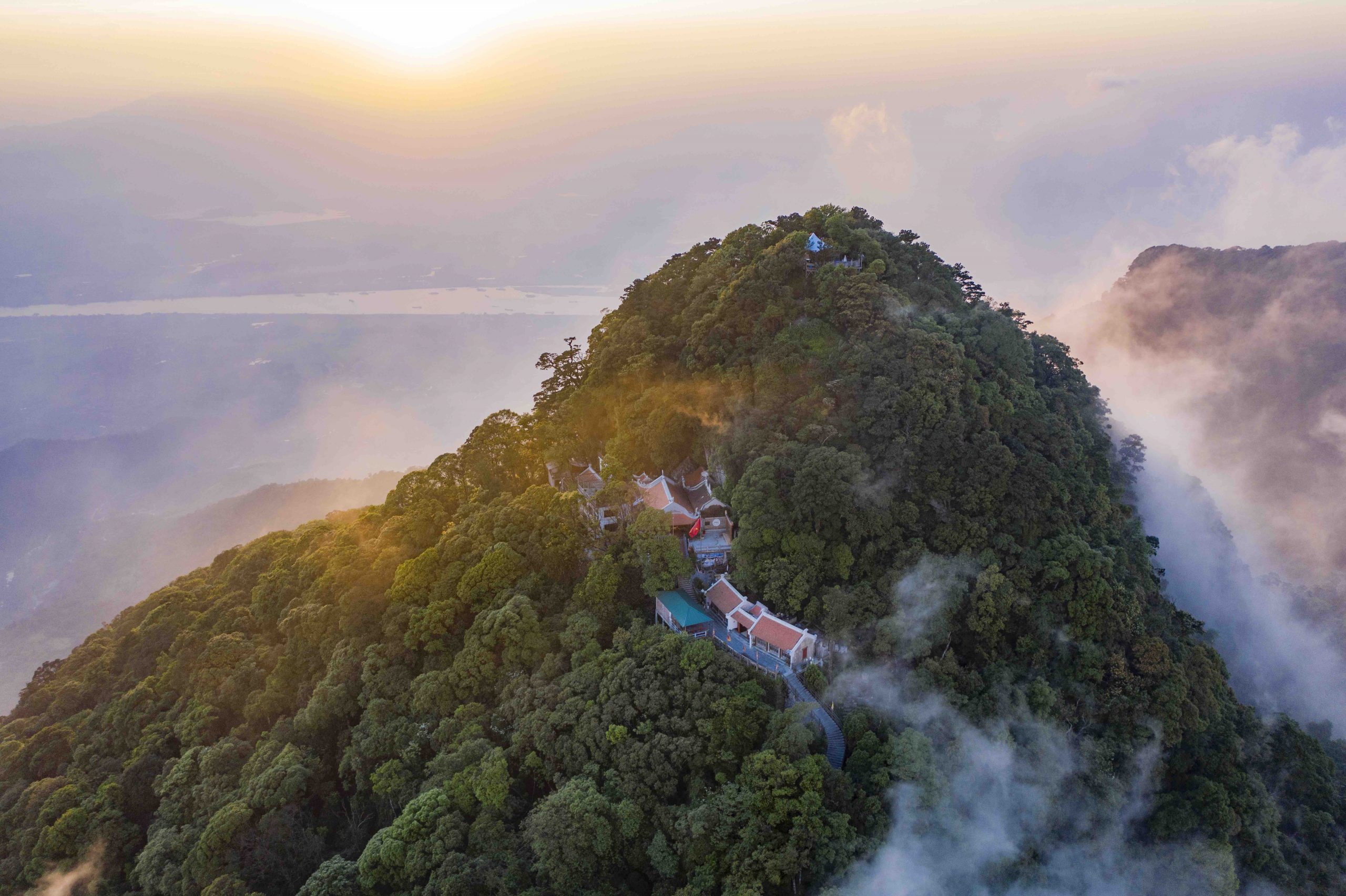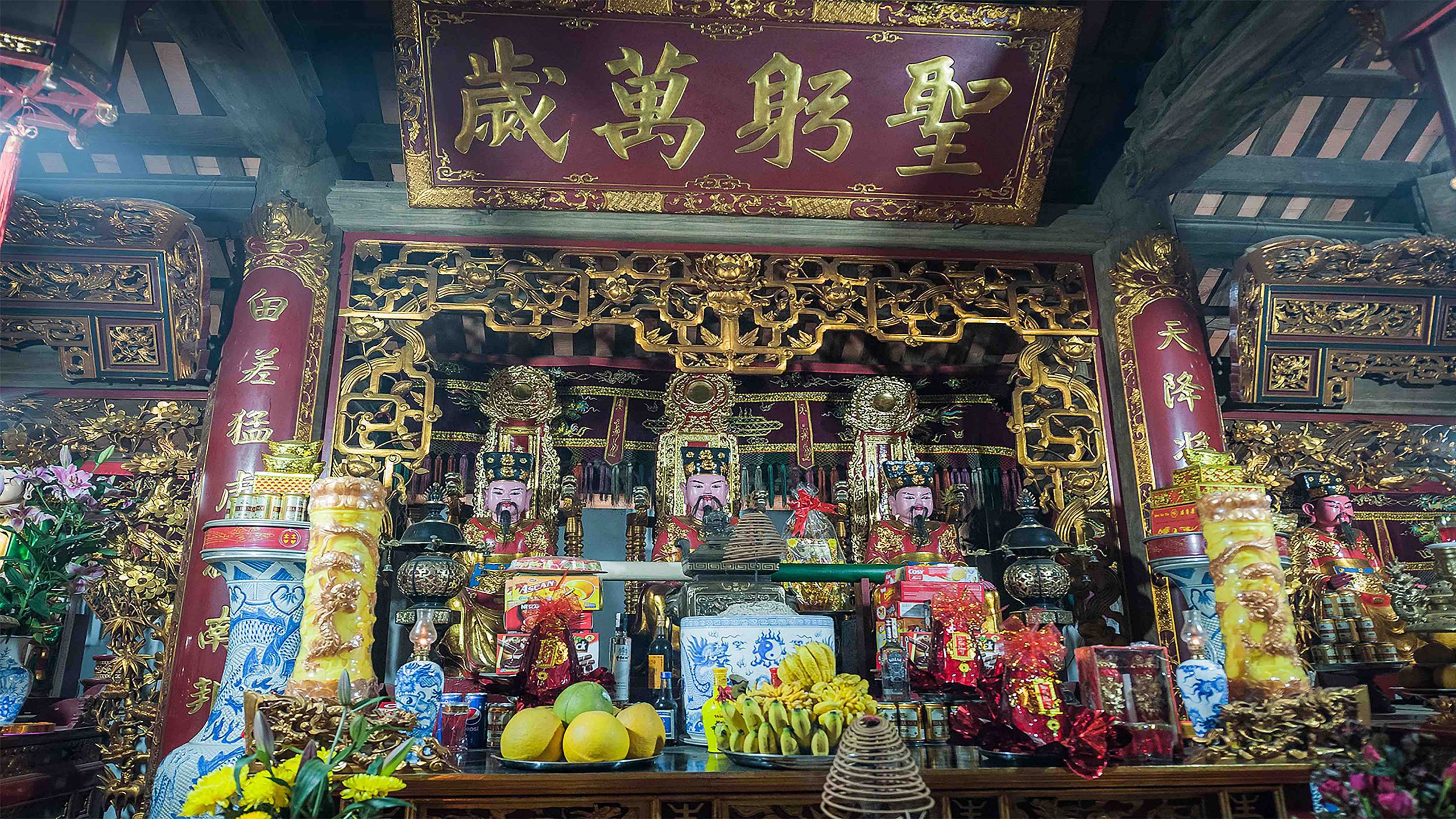Story: Historian Le Van Lan
Photos: Ba Ngoc
Over 200 million years ago, tectonic activity gave rise to a mountainous region covering roughly 7,000 hectares. This area features three prominent peaks: the central peak, Tan Vien, standing at 1,220 meters, with a summit resembling a canopy; the eastern peak, known as Ngoc Hoa or Ba Mountain, reaching 1,120 meters; and the western peak, called King’s Peak or Ong Mountain, which is the tallest at 1,281 meters.

Together, these peaks form a mountainous area locally known as “Ba Vi”. Its classical name in Sino-Vietnamese, recorded in ancient texts, is Tan Vien. The renowned 19th-century scholar Le Dai Cuong famously described Ba Vi – Tan Vien in Bắc Thành Dư Địa Chí (The Geographic Records of Bac Thanh) as: “The guardian mountain of the nation.”
Indeed, the mountain’s imposing presence rises on the northwestern edge of the Red River Delta, casting a spiritual shadow over the “cradle of Vietnamese history and civilization.”
From the heart of the delta’s triangle—particularly from Thang Long (modern-day Hanoi)-two superlatives echo across the ages:
“Ba Vi is the tallest of mountains.
The most tranquil and graceful is the imperial capital of Thang Long!”
Within this context of prominence, the Ba Vi Mountain God, Tan Vien, emerged as a divine figure, embodying the sacred essence of the region.
“The land has its guardian spirits, the river its deities,” reflects the traditional Vietnamese belief that divine forces govern all aspects of nature. This ancient worldview infuses Ba Vi–Tan Vien Mountain with an air of mysticism, elevating its towering presence, fortifying its rugged peaks, and shaping the life and landscapes that surround it. For generations, this sacred mountain has inspired reverence and awe, profoundly influencing the spiritual and cultural life of its inhabitants.
From the earliest times, mythology provided a home for the deity of Ba Vi – Tan Vien. Across cultures and regions, myths often celebrate the colossal and awe-inspiring, and the Ba Vi Mountain God was no exception. The early Vietnamese envisioned this deity as a towering figure of boundless strength.
One of the most celebrated myths surrounding the Mountain God recounts his heroic deeds during a great flood. As the waters surged, the god tirelessly gathered soil to build embankments, shielding the land from devastation. Even the soil that slipped from his basket or the straps that broke became hills later known as Dum and Vai, immortalized in the proverb: “Dum broke its strap, Vai slipped through the basket.”

Similarly, rice grains spilled during the god’s meals gave rise to a rocky expanse near Che Mountain, now known as Com Roi (Falling Rice) Field, nestled at the mountain’s base.
During the protohistoric period, following the era of mythological creation in prehistoric times, the Ba Vi–Tan Vien Mountain deity transformed into a “humanized god,” a divine figure with human form. This evolution connected the deity to the historical narrative of the Hung Kings of the Lac Viet people, who were instrumental in founding the nation during the final centuries before the Common Era. This transformation was shaped through the narrative art of legend.
In this second phase of deification, the mountain deity retained supernatural powers but became deeply involved in two extraordinary events connected to the Hung Kings. These two feats, which also became divine legacies, were established as follows:
First, the deity became the son-in-law of a Hung King, following a fierce rivalry with Thuy Tinh. With superior offerings from the terrestrial world, the mountain deity—also known as Son Tinh—triumphed over Thuy Tinh and won the hand of the beautiful princess, bringing her to Ba Vi – Tan Vien Mountain. However, this victory led to subsequent challenges in the form of devastating floods unleashed by the angry and jealous Thuy Tinh. As the savior of the kingdom and its people under the Hung Kings, the deity rose to the occasion, performing the miraculous feat of building dikes to control the floods and ultimately defeating Thuy Tinh. This feat became intertwined with the image of Ba Vi–Tan Vien Mountain, originally composed of three horizontally aligned peaks. The deity elevated them into three distinct tiers, giving rise to the name “Ba Vi.”
The second feat saw the deity become a general under the Hung King during the “Hung – Thuc War” of the third century BCE, a conflict between the Tay Au tribe (led by King Thuc) and the Lac Viet tribe (led by King Hung). The mountain deity helped King Hung secure multiple victories against King Thuc in the early battles of the war. However, when the Tay Au eventually gained the upper hand over the Lac Viet and established the state of Au Lac in 258 BCE, according to ancient records, the deity transformed into a “Sage of Celestial Origin.” In this role, he embraced the harmonious philosophy of the Viet people, persuading King Hung to relinquish his throne to King Thuc. Thereafter, King Hung and the mountain god chose to wander through the peaks and rivers, delighting in nature’s serene beauty. From that time on, the king and god have been said to linger, subtly manifesting amidst the skies, rivers, and landscapes of Vietnam.

There exists a third layer of deification, dating from the era of Vietnam’s feudal dynasties, created through folklore from the second millennium CE. This layer was influenced by Taoist miracles and the Confucian “Five Constants” of benevolence, propriety, righteousness, wisdom, and fidelity, shaping the mythos of Ba Vi – Tan Vien Mountain. A traditional folk ballad comprising 466 verses, written in the familiar tone and vernacular of 17th-century Vietnamese, aligns closely with oral tales collected from various ancient villages surrounding the foothills of Ba Vi – Tan Vien Mountain. These verses were performed during cultural festivals such as “do singing” events, held once every 36 years in the Quoc Oai region, and “Ca tru singing” in the Phuc Tho area. These performances contributed to the final layer of deification for the Ba Vi – Tan Vien Mountain deity, granting him a human form and identity. In this version, the deity was given a mortal lineage, with a mother named Dinh Thi Den, two paternal cousins named Cao Son and Quy Minh, and a full name—Nguyen Tuan. At times, he appeared as a humble student, and at others, as a woodcutter, characterized by compassion and filial piety. Gifted a “Book of Wishes” and a magical staff by an immortal, he rose to become a “Sage Among Mortals.” He roamed the land, dedicating himself to saving lives and alleviating suffering—not only for humans but also for plants and animals. Notably, he taught people how to farm, sustain their livelihoods, and perform music and dances.
Through three distinct layers of deification—Mythology, Legend, and Folktale—all unified under the name Son Tinh, the Ba Vi – Tan Vien Mountain deity rose to occupy the highest rank in Vietnam’s pantheon of the “Four Immortals”, comprised of Son Tinh, Thanh Giong, Chu Dong Tu, and Tu Dao Hanh or Lieu Hanh.
A total of 116 worship sites dedicated to this deity have been recorded around the foothills of Ba Vi – Tan Vien Mountain and across Vietnam. The deity’s primary sanctuaries are the three sacred temples of Thuong (Upper), Trung (Middle), and Ha (Lower), located respectively at the summit, mid-slope, and base of Ba Vi – Tan Vien. The deity is also believed to have four grand palaces located in the cardinal directions—east, west, south, and north—around the mountain’s base. Among these, the most imposing, majestic, and ancient is Va Temple in Son Tay Town. These temples are revered spiritual destinations, attracting countless visitors each spring.










